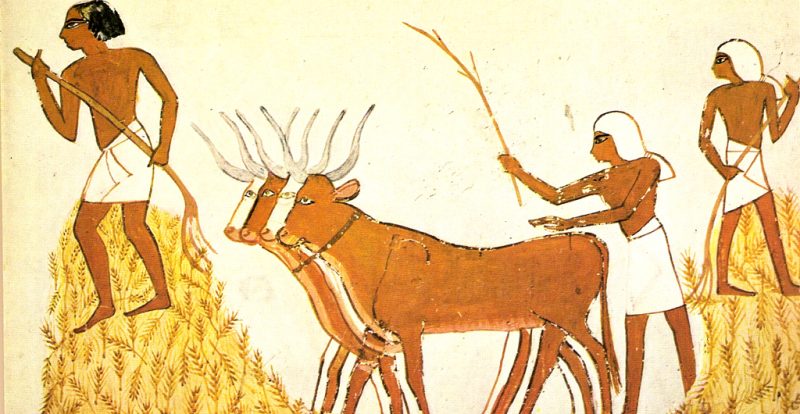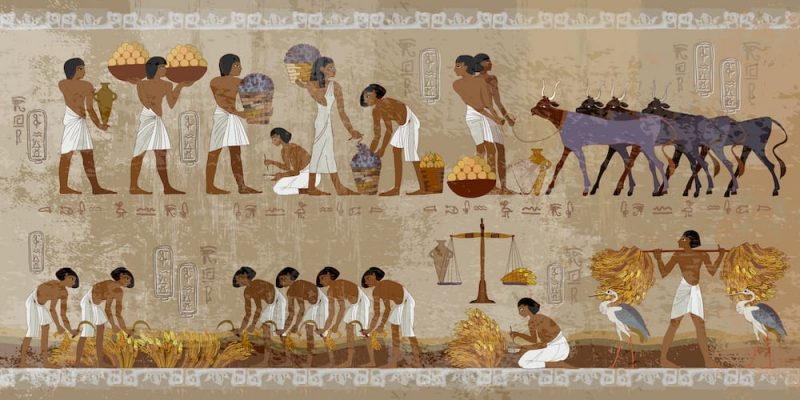We explain what the first agricultural civilizations were and their characteristics. Also, how they developed in different places around the world.

What were the first agricultural civilizations?
The first agricultural civilizations were the societies that autonomously developed agriculture and became civilizations with a complex organization with surplus production, social hierarchy and centralization of power.
The first agricultural civilizations were those of Sumer (3300 BC), Egypt (3200 BC), India (2400 BC), China (3000 BC), Mesoamerica (1200 BC). ) and the Central Andes (1200 BC). These civilizations settled on the banks of rivers and developed increasingly complex techniques in agriculture, which allowed them to have surplus production. That is to say, obtained more resources than necessary for their subsistence.
The existence of surpluses allowed the growth of the population, the specialization of work, the appearance of social hierarchies and, later, the centralization of power. Therefore, the first agricultural civilizations were the first societies to develop a state organization.
- See also: Ancient civilizations
Characteristics of the first agricultural civilizations
The first agricultural societies were not linked to each other. Most of them belonged to a different region and time. So these are different societies, each with its own culture and characteristics.
However, The development of agriculture generated the same general long-term changes in all of them: sedentarization, the development of urban centers, the hierarchization of society and, as a consequence, the appearance of the State.
Among the main common characteristics of the first agricultural civilizations are:
Hydraulic companies
The practice of agriculture established the need for irrigation and access to water. Therefore, the first agricultural civilizations are societies that were founded on the banks of rivers and, in addition, they developed techniques for the storage and control of water (such as canals and dams).
For example, the civilizations of the Near East developed around the Tigris and Euphrates rivers, and that of Egypt, around the Nile River.
Agricultural practices
The first societies developed intensive agriculture for which they used farming instruments and irrigation systems.
Surplus production
With agricultural and livestock practices, societies transformed their subsistence economy into a productive economy. Over time, crops began to generate surpluses. That is to say, more food was produced than the community needed for their survival.
This production of surpluses resulted in population growth, the appearance of barter (the first form of commerce) and social hierarchy.
Population growth
With the greater availability of food, agricultural populations grew in number and size and villages became urban centers.
Social hierarchy
Population growth and the development of agricultural practice led to a specialized division of labor that, in the long run, generated social differentiations.
Ruling classes appeared that managed society's resources (they organized the distribution of water and the construction of large works, and administered taxes). For their part, peasants and urban workers (artisans) were dedicated to production and had to deliver part of their productive surpluses as tribute.
Development of new techniques and inventions
Job specialization generated a great development of inventions and work techniques in different areas. For example, metallurgy and writing were developed, or the wheel, boats and the plow.
Origin of the first agricultural civilizations
The first agricultural civilizations emerged as a consequence of the changes produced by the development of agriculture. This happened at different times in different regions:
- In the Fertile Crescent (the valleys of the Nile, Tigris and Euphrates rivers), the first agricultural settlements date back to 8000 BC. C and gave rise to the civilizations of Asian Mesopotamia and Egypt.
- In the Indus River Valley, agriculture appeared around 7000 BC. C and laid the foundations for the ancient civilization of India.
- In the Huang Ho River Valley, the first crops date back to 6500 BC. C and allowed the later civilization of Ancient China to develop.
- In Mesoamerica, around 8000 BC. C., the first agricultural settlements appeared that, centuries later, led to the appearance of the civilizations of the Olmecs and Teotihuacán.
- In the highlands of the Central Andes, the oldest crops appeared in 7000 BC. C and laid the foundations for the subsequent development of the civilizations of Chavín, Nazca and Tiahuanaco.
In these societies, the practice of agriculture generated a series of changes that transformed social relations and forms of economic organization. This set of changes is known as the “Neolithic Revolution” or “neolithization process” and begins the period of prehistory known as the Neolithic (the third stage of the Stone Age). Therefore, The first agricultural civilizations are societies that went through the changes of the Neolithic Revolution.
Agricultural practice is linked to other fundamental changes: sedentarization, livestock farming, the appearance of villages, changes in stone polishing techniques and new inventions (such as ceramics or metal smelting). This new way of life also led to new ways of dividing labor within the community, which modified social relations.
Over time, these transformations led to the creation of urban centers with social hierarchy and centralization of power, and to the appearance of the first States.
- It may help you: Bronze Age
Mesopotamia
Asian Mesopotamia It is the territory that covers the fertile space surrounding the Tigris and Euphrates rivers. It belongs to the region known as the Near East or Western Asia, which is comprised between the Armenian Mountains (to the north), the Syrian Desert and the Persian Gulf (to the south), the Zagros Mountains (to the east) and the Mediterranean Sea ( to the west).
This region has a relief in which plateaus and river plains coexist, formed by the sediments of the Tigris and Euphrates rivers, rich in clay and silt (keys to soil fertility).
The first agricultural settlements appeared around the year 8000 BC. c and they grew wheat and barley. Since rainfall is scarce in the region, cultivation required the use of river waters, for which large irrigation canals were built.
Around 3000 BC. C., the Mesopotamian population had grown and created different urban settlements that were supplied through agriculture, livestock and commercial exchanges. Furthermore, the first state organizations such as city-states were developed at that time.
City-states were autonomous political entities which had their own laws and institutions. However, the different cities of Sumer (as the region was called) shared a cultural identity based on language, belief and value system, religion and writing.
The Sumerians developed a hierarchical society which included the existence of a privileged group that came to power (characterized by warrior and religious functions), a group of artisans and merchants who provided services to the city, and a group of peasants who, with their work, supported the entire the community. The peasants had to give part of their production as tribute. In addition, there were slaves, who were prisoners of war.
- Mesopotamia
Egypt

The ancient Egyptian civilization arose on the banks of the Nile River, whose regular and predictable floods left fertile silt and sediments usable for planting. It is estimated that The first agricultural settlements on the Nile River date back to 8000 BC. c
In the 4th century BC. C., the urban settlements of Egypt began to have the characteristics of a complex society. The Egyptians first organized themselves into “nomes” (territorial units under the rule of some families) and then the nomes were unified into two great kingdoms: the northern one (in the Nile River delta area) and the southern one ( in the valley area).
Around 3300 BC. C., the two kingdoms were unified under the figure of King Nemes who proclaimed himself pharaoh and established the first of the dynasties of Ancient Egypt.
In this region, it was essential to distribute the water of the Nile River through canals. The State had a fundamental role in the economy because it managed water control and organized the construction of different hydraulic works.
The Egyptian state developed an organization that established that all lands in the kingdom belonged to the pharaoh, who delegated them to priests and government officials. In turn, they assigned them to soldiers and peasants to work on them in exchange for paying tribute.
India

The first farmers in the Indian subcontinent region emerged around 7000 BC. c and were part of a group of cultures from the Indus River Valley called “pre-Aryans.”
The agricultural settlements in the region, which later gave way to the first fortified cities, were dedicated to cultivating wheat, barley, sesame, legumes, dates and melons.
Around 2400 BC. C., a civilization known as the Indus culture developed. Its most important cities were Harappa and Mohenjo-Daro. These urban centers had a system of canals and sewers that allowed water to be carried to houses.
Indus culture had a hierarchical society divided between the families that monopolized the spaces of power, and the peasants, who gave part of their production as tribute.
Around 1500 BC. C., there was an invasion of Aryan tribes of Indo-European origin. These tribes destroyed the cities and settled in the Indus region.
China

The oldest evidence of agricultural development in the Chinese region dates back to 6500 BC. Around the year 3000 BC. C., a culture that gave rise to the ancient Chinese civilization developed in the valleys of the Huang Ho and Yang Tse rivers.
It is estimated that around 1700 BC. C., the entire region came under the power of a single dynasty for the first time. Specialists maintain that the Shang dynasty ruled over a culture that descended from the Neolithic populations of northern China.
Chinese culture It was characterized by having a complex social organization with a very marked social hierarchy. Power was centralized in the king, who had a group of officers and officials at his service. Then, there were artisans and peasants who paid tribute. In addition, there were slaves who were prisoners of war and were assigned to agricultural work.
This civilization also developed a unique architectural and artistic style and created a writing system that became more complex with the passage of time and different uses.
- Ancient China
Mesoamerica
The Mesoamerican region covered the territories of present-day Mexico, Guatemala, El Salvador and Belize. Around the year 5000 BC. C., the first corn crops appeared in the Tehuacán Valley (located in what is now Puebla, Mexico).
To harvest corn, a tool called coa was created (it was like a shovel with a sharp edge) and very different cultivation techniques were developed, such as slashing or terrace cultivation. Other foods grown in the region were cocoa, tomato, avocado, pumpkin, chayote, sweet potato, cassava, vanilla, cotton and tobacco.
Around 1200 BC. C., the first urban cultures were developed in different parts of Mesoamerica. These civilizations were characterized by the construction of urban centers planned and managed by ruling classes that based their power on religious beliefs.
The Olmecs settled in the Gulf of Mexico region. Around 800 BC. C., they dominated a large part of the agricultural villages in the area. Its main city was La Venta. From there, they imposed their religion and belief system on the entire population.
The priests occupied positions of power and the population believed that they were intermediaries between people and the gods. Their tasks were considered sacred and essential to the continuity of civilization.
- Mesoamerica
South American Andean cultures

In parallel to Mesoamerica, In the Central Andes, the first crops appeared around 7000 BC. c with the production of pumpkins, quinoa and squash. Around 3000 BC. C., other crops such as corn, potatoes, beans, lucuma and coca were incorporated.
The first complex civilization of the Andes was the Chavín culture, which developed around 1200 BC. C. As in Mesoamerica, the ideological influence of the priests allowed them to centralize political power and consolidate themselves as rulers of the population.
From the temples, the priests exercised the functions of government and state administration. The goods that the rest of the population gave as tribute were stored there.
document.addEventListener(“DOMContentLoaded”, (e) => {
var sliderContainer, slider;
sliderContainer = document.getElementById(‘block_181ac4acd7efce2ca93b05592c9dbf52’);
if (typeof initSlider !== ‘function’) {
console.log(‘Swiper haven\’t been loaded’);
sliderContainer.className += ‘ fw scroll-snap’;
return;
};
options = {
direction: ‘horizontal’,
speed: 1000,
slidesPerView: ‘auto’,
// slidesPerGroup: 1,
centerInsufficientSlides: true,
// centeredSlides:true,
spaceBetween: 15,
breakpoints: {
720: {
// centeredSlides: false,
// slidesPerGroup: 2,
spaceBetween: 25
},
},
pagination: {
el: ‘.swiper-pagination’,
type: ‘bullets’,
clickable: true
},
}
slider = initSlider(sliderContainer, options);
})
References
- Galliano, A., Katz, M and others. (2015). The first civilizations. Social Sciences. History and geographical spaces from the origin of man to the Middle Ages. Edelvives.
- González, MP and Massone, M. (2002). Paleolithic and Neolithic societies; Ancient urban societies. Societies. Vicens Vives.
- Marquez, M and Cassano, K. (2010). The first societies of Antiquity; States and empires of Antiquity; States and civilizations of America. Social Sciences 1. Cassava.





